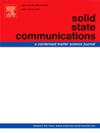Structural and optical investigations of lithium-modified lead bismuth borate glasses
IF 2.1
4区 物理与天体物理
Q3 PHYSICS, CONDENSED MATTER
引用次数: 0
Abstract
Alkali-contained oxide glasses having the composition xLi2O+20PbO+(25-x)Bi2O3+55B2O3 (where 5 ≤ x ≤ 25 mol%) were synthesized at 1423 K by melt quenching process. XRD analysis confirmed the amorphous nature of the glasses, with no crystalline peaks observed. The derived values of parameters viz. density (ρ), molar volume (Vm), crystalline volume (Vc), and interionic distance (Ri) decrease along with the Li2O concentration. Glassy nature of prepared glasses is also confirmed by the lower value of Vc than Vm. FTIR studies indicate that the glasses are composed of [BO4], [BO3], [BiO3], and [PbO4] main structural units, and with the rise in Li2O concentration [BO3] units transformed into [BO4] structural units. Optical absorption study reveals that with the increase in Li2O concentration band gap energy (Eg) increases while cut-off wavelength (λcutoff), and refractive index (n) decrease due to a decrease in nonbridging oxygens (NBOs). The decrease in Urbach energy (ΔE) with increasing lithium oxide concentration suggests a reduction in defect density. The as-prepared glasses exhibit relatively high values of refractive index (2.814–2.509), optical basicity (1.187–1.063), electronic oxide ion polarizability (3.462–2.751 ų), and metallization criterion (0.302–0.361). Thus, these glasses hold potential for applications in technologies such as memory devices, switches, and optical modulators.
锂改性硼酸铅铋玻璃的结构与光学研究
采用熔体淬火工艺,在1423 K下合成了xLi2O+20PbO+(25-x)Bi2O3+55B2O3(其中5≤x≤25 mol%)的含碱氧化玻璃。XRD分析证实了玻璃的无定形性质,没有观察到结晶峰。密度(ρ)、摩尔体积(Vm)、结晶体积(Vc)、离子间距离(Ri)等参数的推导值随Li2O浓度的增加而减小。制备的玻璃的玻璃性质也由Vc低于Vm得到证实。FTIR研究表明,玻璃由[BO4]、[BO3]、[BiO3]和[PbO4]为主结构单元组成,随着Li2O浓度的升高,[BO3]单元转变为[BO4]结构单元。光学吸收研究表明,随着Li2O浓度的增加,带隙能(Eg)增加,截止波长(λ截止)增加,折射率(n)由于非桥接氧(NBOs)的减少而降低。随着氧化锂浓度的增加,乌尔巴赫能量(ΔE)的降低表明缺陷密度的降低。所制备的玻璃具有较高的折射率(2.814-2.509)、光学碱度(1.187-1.063)、电子氧化物离子极化率(3.462-2.751 ų)和金属化判据(0.302-0.361)。因此,这些眼镜在存储设备、开关和光学调制器等技术中具有应用潜力。
本文章由计算机程序翻译,如有差异,请以英文原文为准。
求助全文
约1分钟内获得全文
求助全文
来源期刊

Solid State Communications
物理-物理:凝聚态物理
CiteScore
3.40
自引率
4.80%
发文量
287
审稿时长
51 days
期刊介绍:
Solid State Communications is an international medium for the publication of short communications and original research articles on significant developments in condensed matter science, giving scientists immediate access to important, recently completed work. The journal publishes original experimental and theoretical research on the physical and chemical properties of solids and other condensed systems and also on their preparation. The submission of manuscripts reporting research on the basic physics of materials science and devices, as well as of state-of-the-art microstructures and nanostructures, is encouraged.
A coherent quantitative treatment emphasizing new physics is expected rather than a simple accumulation of experimental data. Consistent with these aims, the short communications should be kept concise and short, usually not longer than six printed pages. The number of figures and tables should also be kept to a minimum. Solid State Communications now also welcomes original research articles without length restrictions.
The Fast-Track section of Solid State Communications is the venue for very rapid publication of short communications on significant developments in condensed matter science. The goal is to offer the broad condensed matter community quick and immediate access to publish recently completed papers in research areas that are rapidly evolving and in which there are developments with great potential impact.
 求助内容:
求助内容: 应助结果提醒方式:
应助结果提醒方式:


